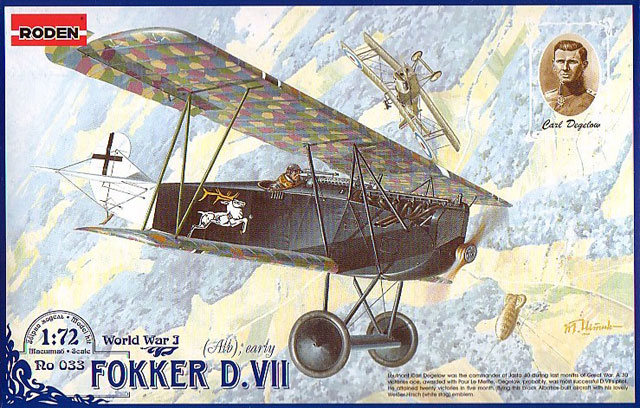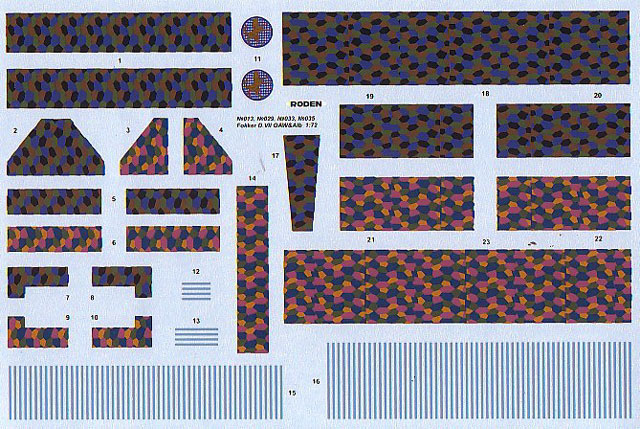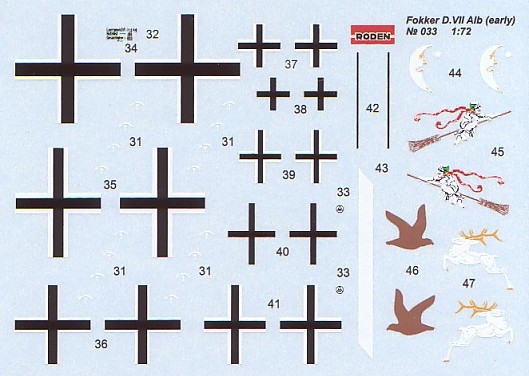|
Fokker D.VII (Alb), Early

Roden

Roden's 1/72
scale Fokker D.VII is available online from Squadron.com
S
u m m a r y
|
| Catalogue Number: |
Kit No. 033 |
| Scale: |
1/72 |
| Contents and Media: |
60 grey plastic parts; markings for
five options including lozenge decals |
| Price: |
USD$8.96 from
Squadron.com
|
| Review Type: |
FirstLook |
| Advantages: |
Well researched, accurate detail,
acceptable lozenge |
| Disadvantages: |
Some fit problems, extra clean up of
parts needed |
| Recommendation: |
Recommended |
Reviewed by Robert Baumgartner
This is Roden's second version of the Albatros built Fokker DVII. Their
previous offering was a "late" representation whereas this kit reproduces
an "early" example.
The Sprues
The parts are molded in a neutral grey colour on four different sprues.
Three of these we have seen before but a new one, labeled G, provide the
fuselage halves for the early built Albatros version. A new radiator also
resides on this sprue.
Click the images below to
view larger images:
There are plenty of extra parts to keep the spare parts box stocked.
Thanks to the use of common sprues with other kits, the modeler gains
with an extra engine, exhaust, propellers, wheels and machine guns.
These sprues do contain flash on some parts, but some gentle sanding
easily removes this.
Accuracy
As with the other kits in this series, everything scales out well with
Ian Stair's plans published in Datafile 9 and the Fokker D.VII Anthology
series. These books are published by Albatros Productions and are amongst
the best on the subject.
With regard to the parts, there is one major discrepancy and this concerns
the under-
carriage axial wing. It is significantly undersize in span and requires
padding at one end with plastic card and the subsequent reinstating of the
axle.
Fuselage
The fuselage halves are molded to the same excellent standards as seen
on previous D.VII releases. On the inside of the parts, there is a nice
representation of the tubular structure and this is also subtlety shown on
the exterior of the fuselage halves. The forward engine access panels are
beautifully done and all items are present in the correct locations.
As expected, the upper engine access panels have been removed which allow
the modeler to take advantage of the superbly detailed engine that is
provided on sprue Z.
Wings
These items are generally good but the lower wing still retains the
upper port wing blemish seen on previous kits. This is not hard to remove
and only takes a couple of minutes with wet and dry. While you're at it,
direct some attention to the trailing edge as there are some dimples that
will require removing.
The upper wing has the correct tapering towards the tips but a slight
dihedral will have to be removed by some gentle bending in hot water. The
rib detail is delicate, as is that on the lower wing, and the trailing
edges commendably thin.
The various struts are as delicate as ever and extreme caution is needed
to remove them from the sprue. Although difficult to cleanup, Roden ought
to be complemented on the finesse of these parts as their use in the
assembled kit is well worth it.
Other Bits and Pieces
Most of the essential cockpit items are catered for and the modeler can
add more if their level of detail desires it. Provided are the floor,
rudder, compass, control column, throttle, and instrument panel.
The engine is a seven-piece affair and the amount of detail is a credit to
Roden, perfect to show off with the removed fuselage panels. The tail
assembly and rudder are well reproduced, the latter even providing for the
slight offset to port.
Assembly
Previous builds of kits in this series have shown that there is some
care needed during assembly.
The lower wing is best cut in half to allow it to fit in the slot created
by the assembled fuselage halves. After removing the inner fuselage plugs,
the engine needs careful alignment to allow it to sit at the correct
height. The forward cockpit deck may benefit from a shim to get it to fit
properly, and for the machine guns to sit at the proper height, the feed
chutes will have to have some of their bulk removed.
None of the above is particularly difficult and patience should reward.
As usual, Roden have provided the builder with an interesting selection
of options, and my examples were in perfect register. The 4- colour
lozenge is from earlier releases and is most welcome.

The rib tapes, although of the correct colour, are too thick and will need
cutting in half to be useable.
The five options catered for are
-
Fokker D.VII (Alb) flown by Ltn. August
Hartmann, Jasta 30.
I would suggest adding a bit of orange to the yellow quoted in the
instructions as this would be more consistent with the colour mentioned
in the British intelligence report.
-
Fokker D.VII (Alb) Jasta 36 1918.
Note that this machine had a flare rack on the starboard side under the
cockpit opening.
-
Fokker D.VII (Alb) flown by Ltn. R.F.Jakobs
Jasta 43 1918
The crescent moon insignia was handed on this aircraft and unfortunately
the decals do not reflect this. Note that there is also what appears to
be
repaired patches for previous bullet holes on the fuselage.
-
Fokker D.VII (Alb) flown by Ltn. d.R Carl
Degelow, Jasta40 1918
This machine also carried a telescopic sight, which is easily
scratch-built from
rod. Details of this can be copied from the box top. Unfortunately this
aircraft carried five-colour lozenge and not the four-colour variety
that is
provided in the box. For this machine do not apply the axle propeller
decals as this aircraft has been seen photographed with a Garuda
propeller.

Another fine product that will round out the Fokker D.VII series of
aircraft very nicely. The excellent level of research and the
well-produced details, mean that only the fastidious will feel the need to
change anything (under carriage axial excepted).
The minor fit problems are easy to fix and Roden are to applauded for
keeping
the WW1 enthusiast salivating for more.
Thanks to
Squadron.com for the review
sample.
Review and Images Copyright © 2002 by
Robert Baumgartner
Page Created 14 May, 2002
Last updated 22 July, 2003
Back to HyperScale Main Page
Back to Reviews Page
|
Home | What's
New | Features
| Gallery |
Reviews | Reference
| Forum
| Search